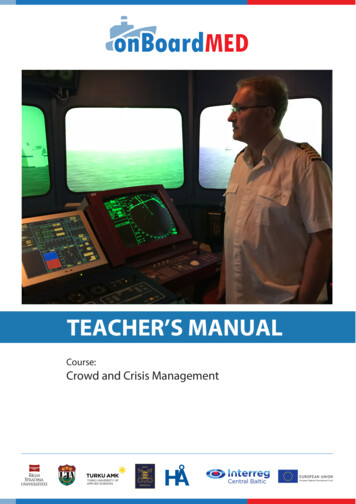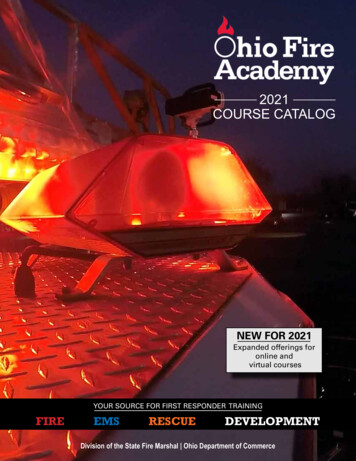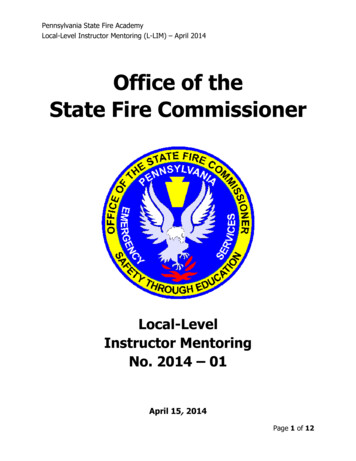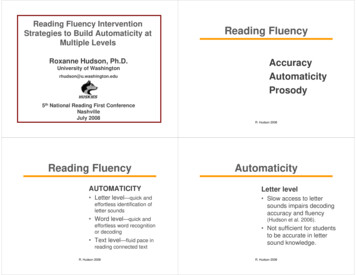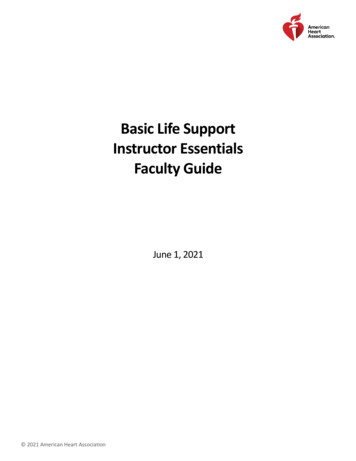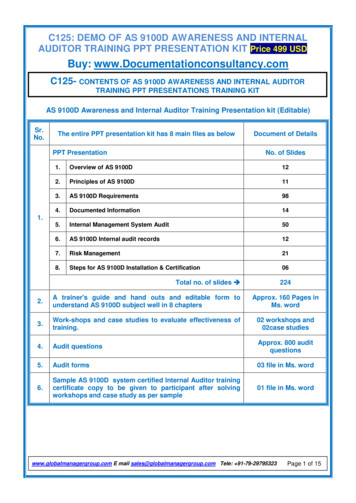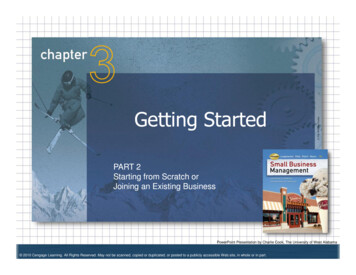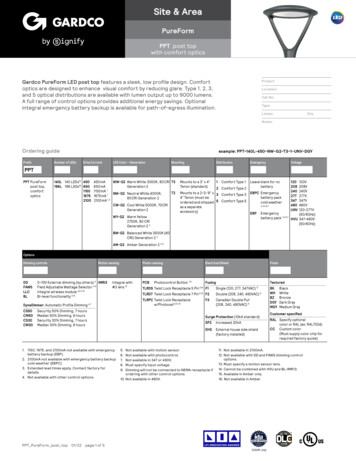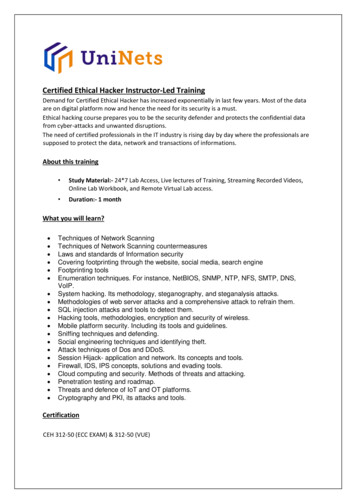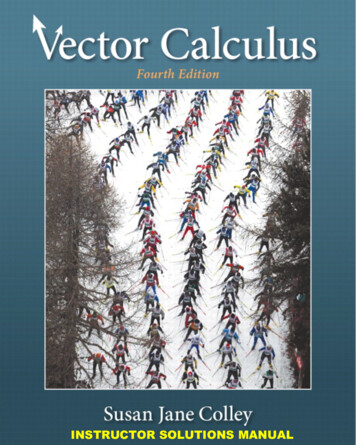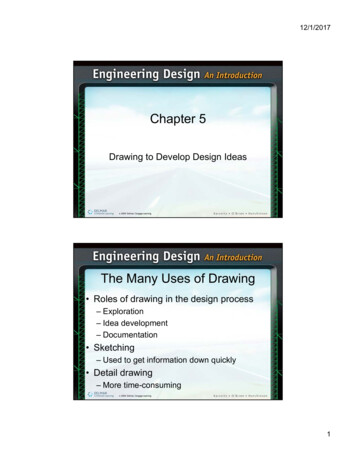
Transcription
12/1/2017Chapter 5Drawing to Develop Design IdeasThe Many Uses of Drawing Roles of drawing in the design process– Exploration– Idea development– Documentation Sketching– Used to get information down quickly Detail drawing– More time-consuming1
12/1/2017Exploring the Visible World Exploration– How we gather information Visual sense– Accounts for up to 90 percent of informationhumans take in Drawing– Helps understand how parts relate to oneanotherDeveloping Ideas Developing solutions– Involves generating and manipulating ideas First ideas are rough– Sketching allows building on ideas– Successive drawings capture improvement Draftspersons hand-inked productiondrawings in the past– Computer-aided drafting used today2
12/1/2017Documenting the Process Documentation– Collecting evidence of the thinking process– A record of ideas and development work Engineer’s notebook– Used in industry– Careful record of ideas, calculations,thoughts, and plans– May be used to support a patent application3
12/1/2017Documenting the Process(cont’d.) Design portfolio– Used in creative fields– Documents the thinking and physical work ofan individual– May include previous projectsCommunicating ThroughDrawing Drawing– A skill that can be learned– Techniques can help develop basic skills Barriers to learning to sketch and draw– Fear of not being able to sketch– Fear of looking foolish4
12/1/2017Whole-Brain Drawing Verbal thinking: left brain Visual thinking: right brain– Artists use when drawing, painting, sculpting Exercises and activities– Can help develop right brain Ultimate goal– Both halves of brain working togetherWarm-Up Exercises Exercise 1: Drawing mirror images– Helps mobilize the right brain5
12/1/2017Warm-Up Exercises (cont’d.) Exercise 1: (cont’d.)– Draw the profile of a witch at the right edge ofa piece of paper– Draw a mirror image of the face along the leftside of the paperWarm-Up Exercises (cont’d.) Exercise 2: Turn it upside down– Draw woman’s face from Figure 5-11– Next, turn picture you were copying upsidedown– Try to copy the upside-down drawing– Compare the two drawings Second drawing uses more right brain– Judging distances and spatial relationships6
12/1/2017Warm-Up Exercises (cont’d.) Exercise 3: Blind contour drawing– Draw your hand holding a small object– Travel along the contour of the hand First with eyes Then using pencil on paper Don’t look at the paper Practicing contour drawing– Improves seeing details, judging distances,and controlling the drawing handWarm-Up Exercises (cont’d.) Exercise 4: Positive and negative shapes7
12/1/2017Drawing Basics Line– Line width is important to a sketch– HB pencil can make faint or bold lines– Has different qualities: Straight, curved, sharp, fuzzy, and uniform orvaried thicknessDrawing Basics (cont’d.) Shape/Form– Two dimensional space enclosed within lines– Can be natural (organic) or geometric Or combination of the two Rectilinear shapes– Shapes made using only straight lines Form– Shape with three dimensions8
12/1/2017Drawing Basics (cont’d.) Shading– Result of light falling on the object’s surfaces Value– Range of shades– Blackest black of your pencil is darkest value– White of the paper is lightest value9
12/1/2017Drawing Basics (cont’d.) Light source and shading– Light most often comes from one main source Think of light source as coming over leftshoulder Shade forms along their long axis10
12/1/2017Color Hue– Refers to a specific wavelength of light Chroma– Describes brightness or intensity of a hue Value– Sometimes refers to lightness or darkness ofa hue Tints and shadesColor (cont’d.) Primary colors Secondary and tertiary colors Analogous colors– Close to one another on the color wheel Complementary colors– Colors from opposite sides of the wheel11
12/1/2017Texture Can be nature of material itself– Or result of a production process Artists’ tricks for simulating texture– Make rubbings over an actual texture– Scans of real textures12
12/1/2017Space Five spatial cues– High and low position– Large and small relationships– Overlapping– Lines converging as they move away– Atmospheric haze makes close things sharperthan faraway thingsSketching and DrawingTechniques Perspective drawing– Used to represent three-dimensional objectsin two-dimensional space– Uses a vanishing point Isometric drawings– Do not use a vanishing point Technical drawings– Contain information needed to produce item13
12/1/2017Perspective DrawingPerspective Drawing (cont’d.) Exercise 5: Cube in one-point perspective14
12/1/2017Perspective Drawing (cont’d.) Interior views– Horizon line placed slightly above center– Vanishing point centered on this line Two-point perspective– Viewing at an angle to the object Closest part of object is an edge not a face– Placement of horizon line depends on eyelevel you want to represent15
12/1/2017Perspective Drawing (cont’d.) Understanding perspective visually– Simple aid: place transparent grid over thescene– Helps organize what we see Isometric drawing– Drafting convention– Covered in detail in Chapter 10Other Drawing Conventions Crating– Process of visualizing the object you want todraw inside a box or crate Sighting for proportion– Visual measurement– Helps determine relative points in a drawing Outlining– Stands out against the background16
12/1/2017Other Drawing Conventions(cont’d.) Adding a background– Contrasting background helps focus attentionon the object Colored pencil techniques– Use for shading and soft transitions– Good for matte surfaces Color marker techniquesUsing Drawings in the DesignProcess Preliminary sketches– Develop and present your ideas Annotated sketches– Adds notes about materials, fasteners, andother features Developmental sketches and drawings– Add more detail as ideas are refined17
12/1/201718
12/1/2017Using Drawings in the DesignProcess (cont’d.) Production drawings– Final stage– Contain information needed to actually makethe solution– Often drawn to scaleDeveloping an Engineer’sNotebook and Design Portfolio Engineer’s notebook– Typically bound with numbered pages– Keeps written record of all completed work Design portfolio– Used to show the design process to clients– Aesthetic presentation is important19
12/1/2017Portfolio Components of a portfolio– Title page– Page numbering– Table of contents– Often landscape orientation– Logo– Binding on the left side or the top– Page contentPortfolio Page Layout20
Sketching and Drawing Techniques Perspective drawing –Used to represent three-dimensional objects in two-dimensional space –Uses a vanishing point Isometric drawings –Do
